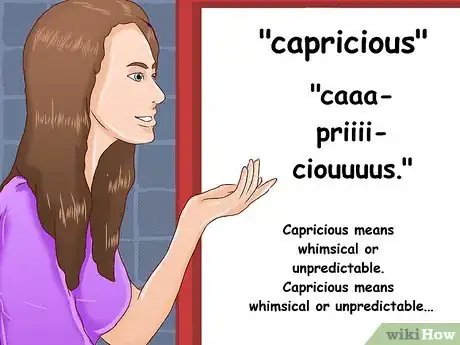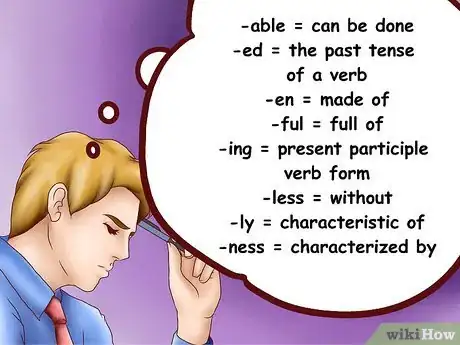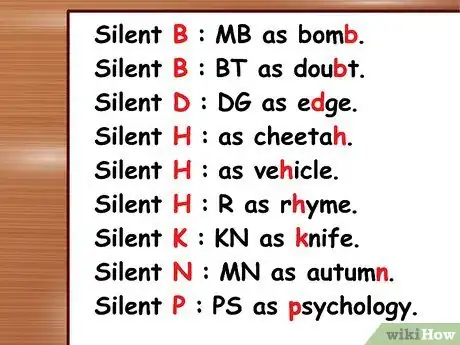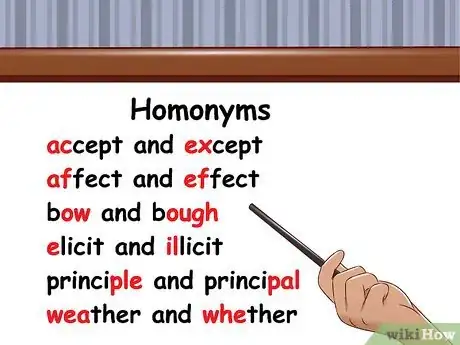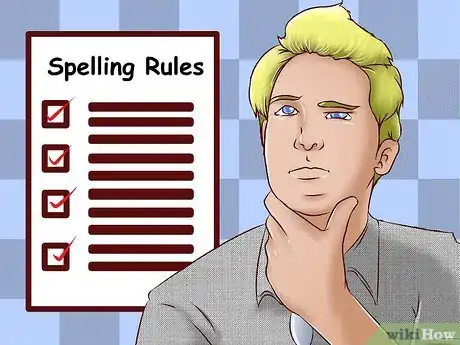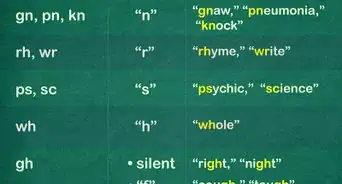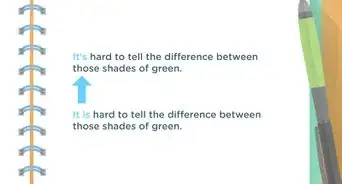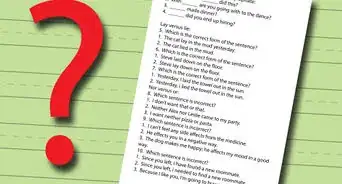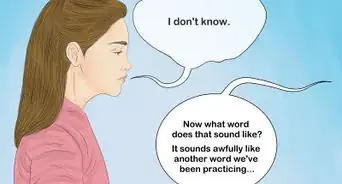This article was co-authored by Emily Listmann, MA. Emily Listmann is a private tutor in San Carlos, California. She has worked as a Social Studies Teacher, Curriculum Coordinator, and an SAT Prep Teacher. She received her MA in Education from the Stanford Graduate School of Education in 2014.
There are 19 references cited in this article, which can be found at the bottom of the page.
wikiHow marks an article as reader-approved once it receives enough positive feedback. In this case, 81% of readers who voted found the article helpful, earning it our reader-approved status.
This article has been viewed 42,341 times.
Training for a spelling bee requires commitment and patience. It also requires a huge love of spelling! Make sure you don’t make your training too stressful. You want to also have some fun.
Steps
Learning New Words
-
1Read as much as possible. Try to read something every day, even if it’s not much. Read anything that might put you into contact with new words. Don’t worry if you are not able to finish something you’re reading. Your main goal is to find words you don’t know and increase your vocabulary.
- Read books, magazines, news articles, pamphlets, and packaging.
- Keep a list of new words. It’s a good idea to use a dedicated notebook or folder to keep track of new words so you can always easily access it and refer to it when you need.
-
2Learn word meanings. Buy a dictionary and look up the meaning of any word you don’t know. You can also use an online dictionary or a phone app to discover the meaning of unfamiliar words.[1]
- Practice understanding the word by using it in context. Use an example from your life that makes sense to you and will be easy for you to remember. For example, say you learn the word "bombastic," which means important sounding but essentially meaningless. You may watch a local political debate and think to yourself, "Senator Sheridan's speech was bombastic."
- If you're looking up new words online, make sure you use a reputable source. Instead of something generic, like Dictionary.com, use something like the Merriam-Webster website.
Advertisement -
3Use mnemonics to learn new words. Mnemonics are types of techniques used to remember difficult pieces of information. You learn to associate words with images, places, sounds, or other pieces of information to help you better remember them.[2] You can use a mnemonic technique to learn new words. Simply trying to memorize a list of words is not especially effective.
- Group words based on common characteristics. Then, link words using visual association. You can also use the method of loci, which is the technique of imagining a familiar space and placing an item you want to remember in that space.
- You can also make a rhyme or song out of words or create acronyms. Acronyms are a word or abbreviation created using the first letters of words.[3]
- For example, say you need to remember the definition of the word "capricious," which means whimsical or unpredictable. The beginning of the word - "capri" - can remind you of capri pants. You can try envision someone wearing capris while also dancing or laughing in a whimsical manner.
-
4Figure out how to perform word mapping. A great technique for learning how to spell new words is word mapping. This involves looking for patterns in words instead of thinking of words as arbitrary strings of random letters, which makes memorizing words very difficult.[4]
- First, speak the word out loud. As you go, exaggerate or stretch a word by individual phonemes, which are the smallest units of a word that express differences in meaning. For example, you may say "capricious" as "caaapriiiiciouuuus."[5]
- Break up the word into individual syllables. For example, "ca-pri-cious."
- Count the phonemes of a word. There are three phonemes in "capricious."
- Write individual phonemes of a word. There are three phonemes in "capricious."
- Write the word using cursive handwriting and then study the spelling of the word.
- Recite a word’s meaning out loud. For example, "Capricious means whimsical or unpredictable. Capricious means whimsical or unpredictable..."[6]
-
5Learn official study words. Find out if your spelling bee is registered with the Scripps National Spelling Bee. If not, your spelling bee organizer may have their own list of official study words for you to look at.[7]
- Ask for the 100 official words for your grade level.
- Ask for the 450 official words for grades 1 through 8.
- Ask for the 1150 official words in the Spell It! Scripps National Spelling Bee study guide.[8]
Learning About Words
-
1Study word etymology. Learning the origin of a word will help you learn certain rules about the way word spelling functions in the English language. For example, many English language words have their origins in Latin. The Latin root ‘reg’ means king, which means that the word ‘regal’ or ‘regicide’ are in some way related to a king.[9]
- Take your spelling bee list and divide words into language of origin. As you do so, pay attention to common parts of words. See if you notice any roots that point to the word's meaning.
- Download a free study guide from the Scripps National Spelling Bee website. These lists include the etymology of common spelling bee words: http://myspellit.com/
-
2Familiarize yourself with common prefixes. A word changes its meaning when you add a prefix to the beginning of it. Since each prefix has its own meaning, knowing common prefixes will help you more easily understand the meaning of new words. Common prefixes, include:
- Anti- = against
- De- = opposite
- Inter- = between
- Non- = not[10]
- Pre- = before
- Semi- = half
- Sub- = under
-
3Memorize common suffixes. A word can changes its meaning when you add a suffix to the end of it. Suffixes can also be useful for helping you determine what part of speech a word belongs to.[11] Knowing common suffixes will help you more easily understand the meaning of new words. Common suffixes, include:
- -able = can be done
- -ed = the past tense of a verb
- -en = made of
- -ful = full of
- -ing = present participle verb form
- -less = without
- -ly = characteristic of
- -ness = characterized by
-
4Learn about silent letters. Many words in the English language include letters that are not pronounced. This can make things difficult for contestants in a spelling bee.[12] Common examples of silent letters, include:
- Silent B at the end of a word in the combination MB, for example: bomb.
- Silent B in the combination BT, for example: doubt.
- Silent D in the combination DG, for example: edge.
- Silent H when it follows a vowel at the end of a word, for example: cheetah.
- Silent H between two vowels, for example: vehicle.
- Silent H after the letter R, for example: rhyme.
- Silent K in the combination KN, for example: knife.
- Silent N at the end of a word in the combination MN, for example: autumn.
- Silent P at the beginning of a word in the combination PS, for example: psychology.[13]
-
5Keep an eye out for homonyms. Anyone training for a spelling bee needs to learn common homonyms, which are words that are spelled differently and mean different things but share the same pronunciation. This is why it's important to ask for a word's definition in a spelling bee. Study common homonyms and make sure you know the definitions for different homonyms. Commonly misspelled homonyms, include:
- accept and except
- affect and effect[14]
- bow and bough
- elicit and illicit
- principle and principal
- weather and whether
-
6Learn spelling rules. There are many spelling rules that will help make spelling unknown words easier for you. Remember, there are always exceptions to the rule so look out for words that must be memorized separately. Study some of the most important spelling rules in the English language. For example:
- The letter I always comes before E unless it comes after the letter C.
- Add -ES to plural words ending in -S, -SS, -Z, -CH, -X.
- Drop the silent E for most words when adding vowel suffix endings.
- Change Y to I when adding vowel suffix endings.
- Most words that end in -F or -FE change to -VES when made plural.[15]
- No English word will ever end with the letters I, U, V, or J.
- The letter I will never follow another letter I.[16]
Creating a Training Plan
-
1Attend a spelling bee. If you have never been to a spelling bee before, attend one so that you will know what to expect. Seeing other participants in action can give you an idea of what it will be like, what you need to focus on, and how you can best prepare yourself.
- Bring a notepad with you and take notes on things like the words that come up, how participants handle words they are unsure about, and what the most successful participants do differently from the rest.
- If you cannot attend a spelling bee, search for videos of spelling bees online, such as on Youtube.
-
2Assess yourself. Get a sense of what you know and don’t know. Take a look at official spelling bee word lists and identify words that you have trouble spelling and words that don’t seem so difficult. It’s important to know what level you’re at so you don’t try to learn words that are too advanced.
- You may also find it helpful to have a friend or family member do a practice spelling bee with you. They can act as the judge and quiz you on difficult words. This will give you a chance to experience similar conditions to an actual spelling bee.
-
3Create a set of objectives. Write yourself a list that highlights what you expect to learn. Include a timeline for your learning. Make your objectives challenging but realistic. Since there are so many words to learn, having a set of learning objectives will help you stay on track and keep you focused. Plus, you’ll be able to tell if you’re meeting your goals, need to revise your goals, or work harder.[17]
-
4Find an appropriate time and place to study. Figure out when you study best. Research shows that many people study best during the day and early evening. Find a place that is free of outside distractions. Break up your study periods so you don’t study for too long and begin to forget important words.[18]
-
5Put together a training schedule. Take a look at your calendar and determine how much time you have before the spelling bee. This will determine how often you should study. Try to practice at least 30-40 minutes a day.[19]
References
- ↑ https://www.washingtonpost.com/posteverything/wp/2014/06/03/heres-how-to-never-misspell-a-word-again/
- ↑ http://psychcentral.com/lib/memory-and-mnemonic-devices/
- ↑ http://www.merriam-webster.com/dictionary/acronym
- ↑ http://www.auburn.edu/~murraba/spelling.html
- ↑ http://www.thefreedictionary.com/phoneme
- ↑ http://www.auburn.edu/~murraba/spelling.html
- ↑ http://spellingbee.com/study-tips
- ↑ http://myspellit.com/
- ↑ http://www.hexco.com/supplemental-resources/
- ↑ http://teacher.scholastic.com/reading/bestpractices/
- ↑ http://teach.files.bbci.co.uk/skillswise/en17suff-l1-f-what-is-a-suffix.pdf
- ↑ https://howtospell.co.uk/silentletters.php
- ↑ http://www.bbc.co.uk/worldservice/learningenglish/flatmates/episode53/languagepoint.shtml
- ↑ https://wts.indiana.edu/writing-guides/proofreading-grammar.html
- ↑ https://howtospell.co.uk/top-ten-spelling-rules
- ↑ https://www.logicofenglish.com/resources/spelling-rules
- ↑ http://blog.convergencetraining.com/how-to-create-an-effective-training-program-8-steps-to-success
- ↑ http://www.dartmouth.edu/~acskills/success/study.html
- ↑ http://ftw.usatoday.com/2014/05/future-scripps-spelling-bee-champion



